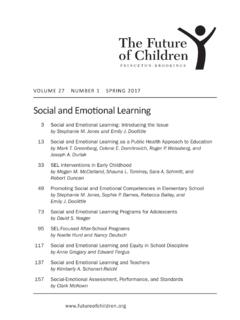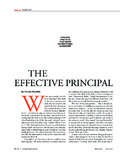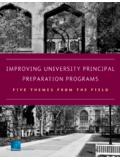Transcription of The Making of the Principal: Five Lessons in Leadership ...
1 10iJ u n e 2012 The Making of The principal : five Lessons in Leadership TrainingperspecTive10iiCopyright 2012 The Wallace FoundationAll rights Wallace Perspective was produced as part of a commitment by The Wallace Foundation to develop and share information about how school Leadership can contribute to improved student Mitgang is the former director of editorial services at The Wallace Foundation. Jennifer Gill is a New Jersey-based writer and editor. This report draws on a decade of work by the foundation on school Leadership .
2 It re-flects the contributions of Wallace staff members Lucas Held, Pamela Mendels, Will Miller, Edward Pauly, Jessica Schwartz and Jody report and other resources on school Leadership cited throughout this paper can be downloaded for free from photo and inside photos of Bob Bender by John Morgan; photos of the Ritchie Program by Omar by Jos Moreno101 The Making of The principal : five Lessons in Leadership Training102execuTive SuMMaryStates and districts facing pressure to have all children meet high standards have been paying overdue attention to improving school Leadership as a way to advance instruction and drive needed changes throughout schools.
3 What will it take to ensure that all public schools have leaders equal to the challenges facing them? That question has placed fresh urgency on addressing the chronic weaknesses of principal training programs, criticized for decades as unselective in their admissions, academically weak and poorly con-nected to school realities. Armed for the first time with compelling, research-validated examples of ef-fective practices, more districts especially large urban districts with the most acute needs have been investing in raising the quality of pre-service training and providing more rigorous mentoring and other support to newly hired principals.
4 And more states have been taking steps including tightening accreditation rules and adopting new standards to push universities and other training providers to improve their districts, such as Chicago and Denver, have collaborated with willing universities to design bet-ter training for aspiring principals. Others, such as New York City, Boston and Gwinnett County, Ga., have formed their own training academies or are working with non-profit training providers to create programs suited to their needs. It s too soon to say for sure, but early evidence suggests payoffs for schools might include lower principal turnover and higher student performance.
5 While these signs of heightened attention are encouraging, there is still a long way to go before the majority of the nation s aspiring principals get the training they need to succeed. Experience and new research suggest that heeding the following five Lessons could help propel many more districts toward the goal of having strong Leadership in every school:1. a more selective, probing process for choosing candidates for training is the essen-tial first step in creating a more capable and diverse corps of future principals.
6 2. aspiring principals need pre-service training that prepares them to lead improved instruction and school change, not just manage buildings. 3. Districts should do more to exercise their power to raise the quality of principal training, so that graduates better meet their needs. 4. States could make better use of their power to influence the quality of Leadership training through standard-setting, program accreditation, principal certification and financial support for highly qualified candidates. 5. especially in their first years on the job, principals need high-quality mentoring and professional development tailored to individual and district Making of The principal : five Lessons in Leadership TrainingBy Lee MitgangFor more than a decade, The Wallace Foundation has worked with states and districts to develop and test ways to improve school Leadership in order to promote better teaching and learning.
7 Improv-ing the often-weak training of principals has been central to that work. Drawing on new research and Lessons from the field, this report updates a 2008 Wallace report , Becoming A Leader: Preparing Principals for Today s Schools. It takes a fresh look at the continuing progress and lingering challenges of providing every school with leaders who have the necessary preparation to help all children succeed as Leadership reconsidered The education field is finally embracing school Leadership as an essential ingredient in reform, worthy of investment in its own right.
8 Facing pressure to have all children meet high standards, states and districts increasingly are recognizing that successful school reform depends on having principals well prepared to change schools and improve instruction, not just manage buildings and budgets. It is the principal , more than anyone else, who is in a position to ensure that excellent teaching and learning are part of every classroom. In fact, Leadership is second only to teaching among school-related factors as an influence on learning, according to a six-year study, the largest of its kind, which analyzed data from 180 schools in nine states.
9 The report by researchers from the universities of Min-nesota and Toronto further noted: To date we have not found a single case of a school improving its student achievement record in the absence of talented Leadership . 1 Stanford University s Linda Darling-Hammond, a leading education scholar and national reform voice, emphasizes the profound impact good leaders have on teaching quality: It is the work they do that enables teachers to be effective as it is not just the traits that teachers bring, but their ability to use what they know in a high-functioning organization, that produces student success.
10 And it is the leader who both recruits and retains high quality staff indeed, the number one reason for teachers decisions about whether to stay in a school is the quality of administrative support and it is the leader who must develop this organization. 2 1 Karen Seashore Louis, Kenneth Leithwood, Kyla L. Wahlstrom, Stephen E. Anderson et al., Learning from Leadership : Investigating the Links to Improved Student Learning, Center for Applied Research and Educational Improvement/University of Minnesota and Ontario Institute for Studies in Education/University of Toronto, 2010, 9.







